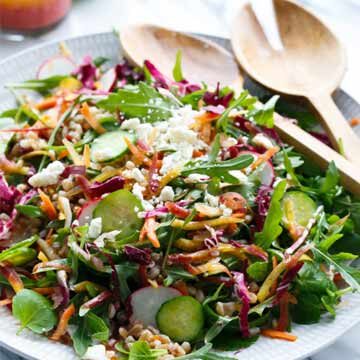
Blood oranges, or red oranges, are an interesting orange fruit variety with dark red flesh. Compared to regular oranges, they taste less acidic, slightly sweeter, and have hints of raspberry or strawberry.
Jump to:
Blood orange season
Blood oranges are in season in winter and early spring, from about December through April. They thrive in Mediterranean climates, so they are mostly grown in California, Italy, and Spain.
Blood oranges (and all citrus fruits) don't ripen after they are harvested from the tree. This means they don't get sweeter or more flavorful once picked. However, there is an upside to this: they store better since further ripening would speed up their decline.
See what else is in season at the same time: December, January, February, March, and April.
Varieties
Most stores don't label the specific blood orange variety. In case you can find the specific varieties, here are the most common ones:
- Moro - The most common blood orange found in the US. The flesh is a darker-red than other varieties, sometimes almost purple. They are the earliest blood orange to ripen. When stored too long the flavor can become off-putting, so don't buy these out of season (after March).
- Tarocco - The favored variety from Italy. The flesh is less red than other blood orange varieties and the peel has little-to-no red-blush. This variety has the sweetest, strongest flavor. They are in season until April (and sometimes trailing into May).
- Sanguinello - The favored blood orange out of Spain. The peel is yellow-orange, often with intense red/blush spots. The flesh is orange with burgundy streaks that can sometimes look brownish. These ripen later in the season.
How to pick
A blood orange that is heavy for its size has more water content, a sign that it is juicy. Ones bought later in the season will be sweeter if they were left to ripen longer on the tree (although that isn't a guarantee, as they could have been picked and then held in cold storage before distribution).
How to store
The thick peel acts as a protective barrier from things that normally cause mold and rot. Combined with the fact that citrus fruits don't ripen after harvest, it allows us to store them for longer than most fruit.
- Whole blood oranges: leave on the counter for a few days, or the fridge for 2 weeks
- Cut halves: wrap the exposed flesh in plastic wrap and store in the fridge for several days
- Segments: store in an airtight bag or container in the fridge for a few days
- Zest: the aroma and flavor don't last long if stored on the counter or fridge. Freezing zest works quite well: spread zest out on a tray to quickly freeze it. Once frozen, transfer to a sealed container and freeze for several months.
- Juice: store in a sealed jar in the fridge for a few days. It freezes well, especially if you freeze into ice cube trays then transfer to an airtight container.
Nutrition & benefits
1 blood orange
- 1 medium blood orange contains:
- ¼ to ⅓ cup of juice
- 2-3 Tbs of zest
- 10 segments
- They are about 10% sugar by weight (for comparison, an apple is 10%, grapes 16%, and lemons 2%)
- They have more antioxidants than other oranges, thanks to the compounds that make their flesh darker
- The peel also has antioxidants, making the zest healthy as well
How to cut & zest
Remove wax before you zest: Blood oranges (and all citrus) are usually coated with a thin layer of wax to prevent moisture loss, which is currently approved by the FDA. Organic blood oranges are also coated in wax, but from an organic source like palm oil. To remove the wax, use a stiff bristle brush (like a vegetable brush) and clean it under hot running water.
Zest the outer, colored part of the peel, stopping when you get to the white part. The white part is the pith and is bitter.
Aroma & the peel
The peel contains an aromatic oil, which is why zest or thin strips of peel smell so good. These oils are volatile, which means they easily release into the air. This is both good and bad.
When the oils get into the air, we smell them, which enhances our perception of taste. There's a real reason bartenders twist an orange peel before putting it on your drink, it's not just all for show.
The downside of the volatility of the oil is that the smell and flavor don't last long after being cut or zested. That's why storing zest on the counter or in the fridge doesn't work well.
Recipes
Blood orange recipes often take advantage of their striking color - a pop of red against leafy greens or a stunning dark red cocktail. The flavor has more depth than most other oranges as well (like navel).
Each recipe below uses ingredients that are in season at the same time as blood oranges, or ingredients that have a year-round season.
































Cindy says
My blood orange tree ptoduced so many oranges this year, we just could not keep up (we juice them).
I had always thought they need to come off the tree before the blooms for next year. Do I need to strip the tree at any specific time?
And, I have frozen the juice many times. This year, however, the defrosted juice looks different. Almost like the pulp got fuzzy, for lack of a better term. Is that normal or is something wrong? If I remove the pulp I am left with a bright magenta juice that tastes great but it looks like Pom juice cut with water. I haven’t had this issue before am I’m very confused
Help…
Thank you
Vee says
I'm so envious of your tree! I've grown lemon and lime trees for almost a decade, and fruit definitely stays on during the next flowering season. I haven't had that affect the crop (or at least, not enough that I would notice for home growing). I know some oranges (specifically clementines) can bear fruit every other year and some people advise picking fruit before the next flowering season to encourage more flowering (but I have yet to verify that advise with agricultural experts). Have you seen your tree alternately bear heavy crops one year followed by small crops another year?
As for the juice, did it have more pulp this year? I know pulp can turn weird and grainy when frozen. I believe it is totally fine, just a texture issue. I wish I was more help on this, but I'll add it to my list of experiments and see if I can dig up more info later on. (By the way, the description of the color of your juice makes it sound so lovely!)
Joshua says
I was on my way to Sequoia National park, April 2nd for my birthday when I discovered Blood Oranges for the first time. I thought something wrong with the orange; however, I carefully ate it. I'm glad did, because I love them now. I like that are not that sweet and very nutritional.
Vee says
I love this story and hope you remember such a fun occasion every time you eat a blood orange 🙂 The first time I saw limequats (like a kumquat, but green and limey), was a trip to London for my birthday and think of that trip every time I see limequats (or even kumquats).
Sandi leTarantula says
I just tried one of these in the last few weeks. A coworker brought them in to work. Didn't know it was a blood orange, let alone they had red innards (this variety, I believe is the Tarocco one, normal orange on the outside & parts of blood red on the inside), I was looking at my fingers to see what I'd cut since I wasn't expecting to see such a redness inside! Lol They've got a wonderful flavor.
Vee says
Glad you enjoyed them 🙂
mae says
just had my first blood red and loved it!
Valerie says
I just found some blood oranges in my local grocery store in July 2021. Can you tell me how they could have been stored, and are they safe to eat, because I see that the growing season is not during July.
Thank you.
Vee says
Great question! They will be safe to eat. Either they were imported from a country from the Southern Hemisphere (where it is their winter), or they were stored in a commercially refrigerated storage unit, where they are able to keep bacteria and fungus out of the air for longer storage.
CHARLETNEWTON says
THANK YOU FOR YOUR TIME, O HAPPY DAY EVERY SINCE BLOOD ORANGE CAME INTO MY LIFE, SUCH OF AN INCREDIBLE FEELING, FOOD GEEK, I THANK YOU FOR ALL YOUR INCREDIBLENESS, IT'S AMAZING, THE REALITY OF BLOOD ORANGE, YUM, YUM, YUM, FOOD GEEK, I THANK YOU FOR EVERYTHING, THANK YOU
CuriousGeorge says
So, I've had a theory going for awhile. In all the years of trying to eay blood oranges they have always tasted slightly rotten to my taste buds. Most people don't get what I'm refering to but those that do reallllly get it. I wonder if like Cilantro something in blood oranges just tastes off (and by off I really do mean slightly rotting, like durian or something) to some of us. I don't mind beer with blood orange flavor to it. But I have tried blood oranges several dozen times hoping I could find one that didn't make me spit it out right away. And I love tart/citrus/winey flavors. Not "rott" though.
Vee says
Interesting! I wonder if you are right about the cilantro-like scenario where it tastes like soap to some people. I found a thread on Houzz where someone has a similar problem. Sadly, I haven't found any scientific studies, but that could be because blood oranges aren't popular enough yet (?).
PRO says
That’s very interesting! Today, I tried one for the first time, and I absolutely love them! On my tastebuds, it tastes like a combination of an orange and a grapefruit, with notes of raspberry.
Vee says
How exciting 🙂 Glad you enjoyed it.
John McCormick says
Areblood oranges same as cara cara oranges?
Vee says
Great question! They are technically different but do share a lot of the same flavor characteristics (a sweet orange flavor with some berry notes). Blood oranges get their darker red flesh color from anthocyanin, a compound that gives other food blue, purple, and red hues (like blueberries and pomegranates).
Cara Cara oranges have more of a pink than reddish-purple color, similar the flesh of a pink grapefruit. The color in Cara Cara oranges comes from lycopene, the same compound that gives tomatoes their red color. They are also generally a lot sweeter (and less bitter) than a blood orange.
Many people prefer to eat Cara Cara oranges as a snack, and blood oranges for salad dressings or other things that can benefit from a slight bitter flavor (which happens when blood oranges are picked early).
Moira McCullough says
Does anyone sell it frozen
Vee says
I haven't ever seen blood oranges sold frozen. Sorry!